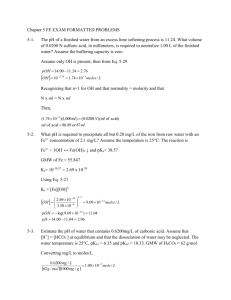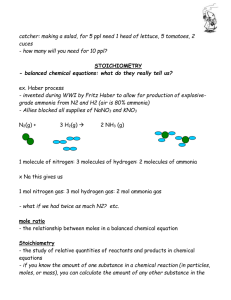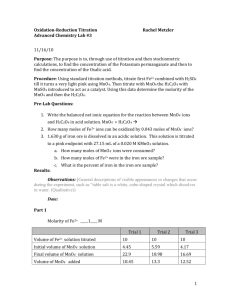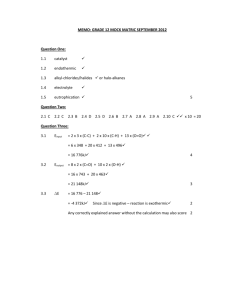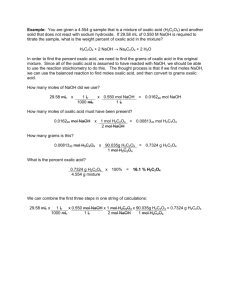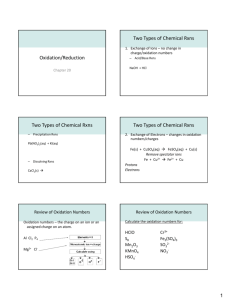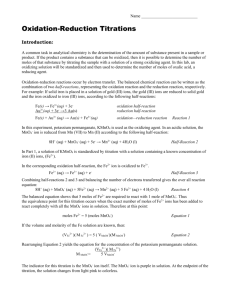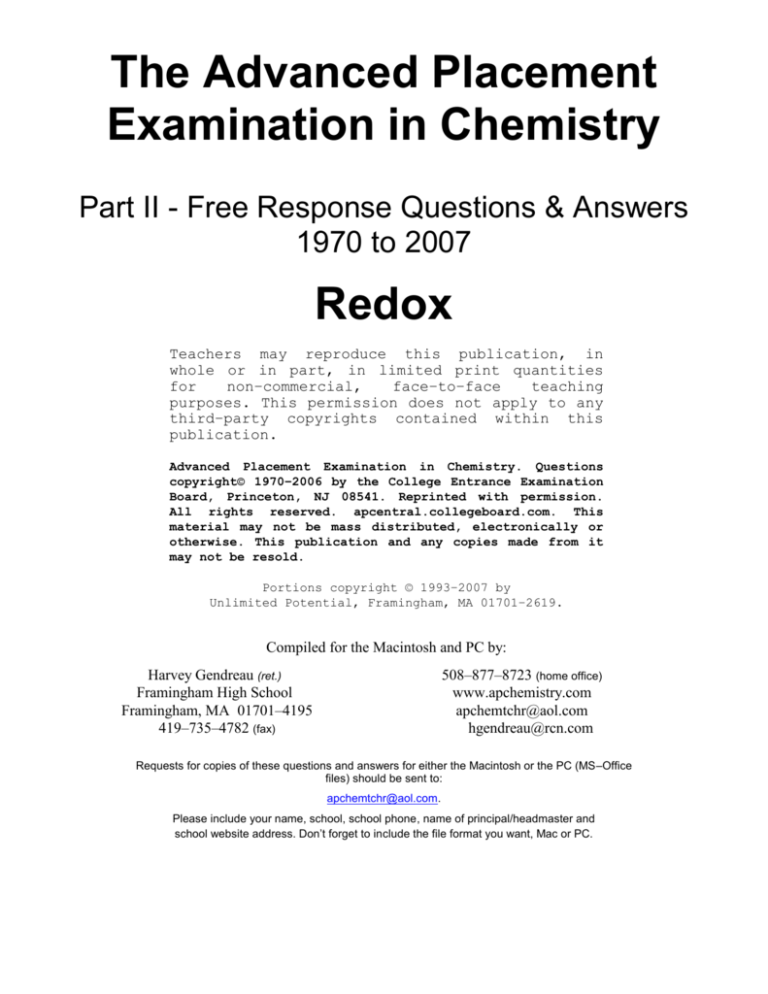
The Advanced Placement
Examination in Chemistry
Part II - Free Response Questions & Answers
1970 to 2007
Redox
Teachers may reproduce this publication, in
whole or in part, in limited print quantities
for
non–commercial,
face–to–face
teaching
purposes. This permission does not apply to any
third–party copyrights contained within this
publication.
Advanced Placement Examination in Chemistry. Questions
copyright© 1970–2006 by the College Entrance Examination
Board, Princeton, NJ 08541. Reprinted with permission.
All rights reserved. apcentral.collegeboard.com. This
material may not be mass distributed, electronically or
otherwise. This publication and any copies made from it
may not be resold.
Portions copyright © 1993–2007 by
Unlimited Potential, Framingham, MA 01701–2619.
Compiled for the Macintosh and PC by:
Harvey Gendreau (ret.)
Framingham High School
Framingham, MA 01701–4195
419–735–4782 (fax)
508–877–8723 (home office)
www.apchemistry.com
apchemtchr@aol.com
hgendreau@rcn.com
Requests for copies of these questions and answers for either the Macintosh or the PC (MS–Office
files) should be sent to:
apchemtchr@aol.com.
Please include your name, school, school phone, name of principal/headmaster and
school website address. Don’t forget to include the file format you want, Mac or PC.
Redox
page 2
1971
Permanganate ion, MnO4-, oxidizes sulfite ions to sulfate ion. The manganese product depends upon the pH of
the reaction mixture. The mole ratio of oxidizing to reducing agent is two to five at pH 1, and is two to one at
pH 13. For each of these cases, write a balanced equation for the reaction, and indicate the oxidation state of the
manganese in the product containing manganese.
Answer:
2 MnO4- + 5 SO32- + 6 H+ 2 Mn2+ + 3 H2O + 5 SO42- (oxidation state Mn = +2)
2 MnO4- + SO32- + 2 OH- 2 MnO42- + H2O + SO42- (oxidation state Mn = +6)
1981 B
A 1.2516 gram sample of a mixture of CaCO3 and Na2SO4 was analyzed by dissolving the sample and
completely precipitating the Ca2+ as CaC2O4. The CaC2O4 was dissolved in sulfuric acid and the resulting H2C2O4
was titrated with a standard KMnO4 solution.
(a) Write the balanced equation for the titration reaction, shown unbalanced below.
MnO4- + H2C2O4 + H+ Mn2+ + CO2 + H2O
Indicate which substance is the oxidizing agent and which substance is the reducing agent.
(b) The titration of the H2C2O4 obtained required 35.62 milliliters of 0.1092 molar MnO4- solution. Calculate
the number of moles of H2C2O4 that reacted with the MnO4(c) Calculate the number of moles of CaCO3 in the original sample.
(d) Calculate the percentage by weight of CaCO3 in the original sample.
Answer:
(a) 2 MnO4- + 5 H2C2O4 + 6 H+ 2 Mn2+ + 10 CO2 + 8 H2O
oxidizing agent: MnO4- , reducing agent: H2C2O4
0.1092 mol 5 mol H 2C2O4
3
(b) 0.03562 L
– 9.7210 mol H 2C2O 4
L
2 mol MnO 4
(c) moles of H2C2O4 = moles CaCO3, therefore, 9.7210-3 mol H2C2O4 = 9.7210-3 mol CaCO3
100.1 g CaCO3
9.72103 mol CaCO3
1 mol CaCO3
100 77.7% CaCO3
(d)
1.2516 g sample
1986 D
(a) Describe what you would see if you added
1. a piece of zinc metal to a test tube that contains 6 molar hydrochloric acid.
2. a piece of copper metal to another test tube that contains 6 molar hydrochloric acid.
(b) Write balanced equations for any reactions that occur.
(c) Explain how you could use the table of standard reduction potentials [attached] to predict the observed
results.
(d) In a separate experiment, concentrated nitric acid is added to a test tube containing a piece of copper metal.
1. Describe what you would see.
2. Explain any differences between the results obtained in this experiment and those obtained with copper
metal in part (a).
Answer:
(a) 1. Bubbling or dissolving of Zn
Redox
2.
page 3
No reaction
(b) Zn + 2 H+ Zn2+ + H2
or
Zn + 2 HCl ZnCl2 + H2
(c) The table shows that Zn is a better reducing agent than H2, so Zn can reduce H+ in HCl to H2. Cu is a
weaker reducing agent than H2, so no reaction occurs when Cu is added to HCl.
(d) 1.
A reaction occurs in which a brown gas is given off OR the solution turns blue or green OR copper
dissolves.
2.
Nitric acid is an oxidizing acid and hydrochloric acid is not. OR Nitric acid is a better oxidizing agent
than Cu2+ is. OR equivalent explanation.
1994 D (Required)
Discuss the following phenomena in terms of the chemical and physical properties of the substances involved
and general principles of chemical and physical change.
(c) What will be observed on the surfaces of zinc and silver strips shortly after they are placed in separate
solutions of CuSO4, as shown on the right? Account for these observations.
Answer:
(c) No reaction in the Ag | Cu2+ beaker because Ag+ is easier to reduce than Cu2+.
The zinc will go into solution as Zn2+ while the Cu2+ will reduce to Cu, forming on the surface of the zinc.
Zn(s) + Cu2+ Zn2+ + Cu(s)
Ecell = + 1.10 v
1998 D
Answer each of the following using appropriate chemical principles.
(d) Identify a chemical species that is
(i) capable of oxidizing Cl-(aq) under standard conditions
(ii) capable of reducing Cl2(aq) under standard conditions.
In each case, justify your choice.
Answer
(d) (i) 2 Cl- - 2 e- Cl2, E = -1.36v Any species that has a reduction potential greater than +1.36v, such as
Au3+ or Co3+ or F2, will oxidize the chloride ion.
(ii) Cl2 + 2 e- 2 Cl-, E = +1.36v Any species that has an oxidation potential greater than -1.36v, such as
Li, Cs, K, will cause chlorine to be reduced.
Questions copyright ⌐ 1970-1998 by Educational Testing Service, Princeton, NJ 08541. All rights reserved. For face-to-face teaching purposes, classroom
teachers are permitted to reproduce the questions. Answers copyright ⌐ 1993-8 by Unlimited Potential, Framingham, MA 01701-2619

